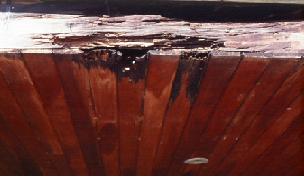 Wood used in exterior applications is subject to several different forms of deterioration. These include wood decay, insects, marine borers and simple weathering or erosion of the surface.
Wood used in exterior applications is subject to several different forms of deterioration. These include wood decay, insects, marine borers and simple weathering or erosion of the surface.
Initially, the need for inexpensive durable timber was driven by the navies of the world and subsequently by the development of the railroads and their need for huge numbers of crossties. The need for telegraph, telephone and utility poles soon followed. To prevent deterioration, man learned that the wood of certain tree species was more resistant than that of others but this material soon became expensive and then difficult to access. In the 1830s different chemicals were already being impregnated by pressure means into wood to extend its useful life.
For exterior woodwork such as decks, siding, trim, windows, doors, casings, etc. decay is probably the most common form of deterioration. Decay fungi, which cause deterioration, are microscopic organisms that have four requirements to function. These are:
- A wood moisture content of 20% or more;
- Presence of oxygen;
- Preferred warm temperature of 70F to 90F; and of course,
- The wood itself, which serves as food.
 Permanently eliminate any one of these conditions and decay will not occur. If these conditions are present only part of the time or they are less than optimal decay will occur more slowly. For example, wood exposed in the south will decay more rapidly because of the predominately warm temperatures and moist conditions throughout much of the year. Wood used inside will not decay because the moisture content is generally in the 6 to 8 percent range. Poison the wood with a preservative or select the heartwood of a naturally durable wood and decay is stopped because the wood is no longer a food source.
Permanently eliminate any one of these conditions and decay will not occur. If these conditions are present only part of the time or they are less than optimal decay will occur more slowly. For example, wood exposed in the south will decay more rapidly because of the predominately warm temperatures and moist conditions throughout much of the year. Wood used inside will not decay because the moisture content is generally in the 6 to 8 percent range. Poison the wood with a preservative or select the heartwood of a naturally durable wood and decay is stopped because the wood is no longer a food source.
Why are there so many decay problems when the explanation is straight forward and the knowledge exists to prevent it?
Table 1 (at the end of this article) shows domestic species grouped by the average resistance of the heartwood to decay. The most durable commercial woods are species such as bald cypress, cedars, redwood, chestnut, white oak and several others. These woods earned a reputation when the old-growth stock was used in decay-prone applications. As the old-growth disappeared, younger timber was cut and used in much the same way.
Although the heartwood of these species still showed resistance to deterioration, the new results were not quite the same. Research on cypress, western red cedar, redwood and some other species has demonstrated that the second and even third growth heartwood is not as durable as the old-growth. In addition, the natural durability of the heartwood varies. Wood from one board may have good resistance but the next board of the same species may not be as durable.
Another very important and often overlooked factor is the presence of heartwood. Only the heartwood exhibits natural durability. Old-growth trees typically have a very large heartwood surrounded by an outer narrow band of white or cream colored sapwood. This narrow band is usually eliminated as round logs are cut into lumber. Young vigorous trees will have a wider band of the light colored sapwood. This sapwood is not milled off and it is usually shipped with the heartwood. In addition, the outer part of today’s smaller trees is the clearest or knot-free part. Specify a high grade of these species and the amount of sapwood included in the shipment will likely increase.
One day, I received a call from an upset owner of a recently built and very expensive home in the South. The man said, “I bought cypress because of its reputation as being durable and I also specified the highest or clearest grade.” He told me the windows and trim on his house had serious decay problems after just five years. Why? The lumber was probably mostly sapwood.
The severity of exposure is another factor which determines the rate at which wood will decay. As an example, a fascia board is fully exposed to the weather and periodic wetting occurences. The soffit, corbels and other decorative woodwork under the eaves is protected and decay is not as likely. Wood such as fence posts or poles in contact with the soil is probably the most vulnerable to decay. The wood preserving industry talks about above ground conditions (less vulnerable) and soil contact (most vulnerable) conditions. For soil contact, the wood is often treated with a larger quantity of preservative. Tags or grade stamps on preservative-treated wood products may indicate what application the wood is suited for.
What to Do!
- Keep wood dry by proper design and construction techniques. Neither sapwood nor heartwood will decay when the moisture content of the wood is below 20%.
- Use preservative-treated wood for soil contact and other vulnerable applications. Make sure you understand how the treated wood is to be used. Read the tag or other information associated with the product. Not all treated wood is suitable for soil contact. Heartwood of commonly treated construction species such as Southern Yellow Pine does not accept treatment. In well treated pine lumber, the heartwood will likely rot first so place these members in less vulnerable situations.
- Today’s naturally durable woods are best suited for above ground applications. If the shipment contains sapwood, sort these pieces and use them in protected areas not subject to wetting.
- Use salvaged or reclaimed heartwood of old growth naturally durable species.
For a more detailed discussion check chapters 14 and 15 in the Wood Handbook, http://www.fpl.fs.fed.us/products/publications/several_pubs.php?grouping_id=100&header_id=p
Table 1.Grouping of some domestic and imported woods according to average heartwood decay resistance.a Source: Wood Handbook
|
Very resistant |
Resistant |
Moderately resistant |
Slightly or nonresistant |
|
Black Locust |
Baldcypress, old growth |
Baldcypress, young growth |
Alder, red |
|
Mulberry, Red |
Catalpa |
Cherry, black |
Ashes |
|
Osage-orange |
Cedar |
Douglas-fir |
Aspens |
|
Yew, Pacific |
Atlantic white |
Honey locust |
Beech |
|
|
Eastern redcedar |
Larch, western |
Birches |
|
|
Incense |
Pine, eastern white, old growth |
Buckeye |
|
|
Northern white |
Pine, longleaf, old growth |
Butternut |
|
|
Port-Orford |
Pine, slash, old growth |
Cottonwood |
|
|
Western redcedar |
Redwood, young growth |
Elms |
|
|
Yellow |
Tamarack |
Basswood |
|
|
Chestnut |
|
Firs, true |
|
|
Cypress, Arizona |
|
Hackberry |
|
|
Junipers |
|
Hemlocks |
|
|
Mesquite |
|
Hickories |
|
|
Oaks, whiteb |
|
Magnolia |
|
|
Redwood, old growth |
|
Maples |
|
|
Sassafras |
|
Pines (other than those listed)b |
|
|
Walnut, black |
|
|
|
|
|
|
Spruces |
|
|
|
|
Sweetgum |
|
|
|
|
Sycamore |
|
|
|
|
Tanoak |
|
|
|
|
Willows |
|
|
|
|
Yellow-poplar |
aDecay resistance may be less for members placed in contact with the ground and/or used in warm, humid climates. Substantial variability in decay resistance is encountered with most species, and limited durability data were available for some species listed. Use caution when using naturally durable woods in structurally critical or ground-contact applications.
bMore than one species included some of which may vary in resistance from that indicated.
Editor's note: Dan Cassens is a professor of wood products manufacturing at Purdue University, W. Lafayette, IN. He works with and organizes educational programs for the fine face veneer industry, hardwood sawmills and furniture manufacturers. He also owns a Wood Mizer sawmill and restores historical buildings.
Guest Blogs Welcome
Got a viewpoint you would like to share with our online woodworking community? Woodworking Network welcomes guest blogs from wood products professionals. Submit your opinions to Rich Christianson, Editor at Large, at [email protected].






Have something to say? Share your thoughts with us in the comments below.